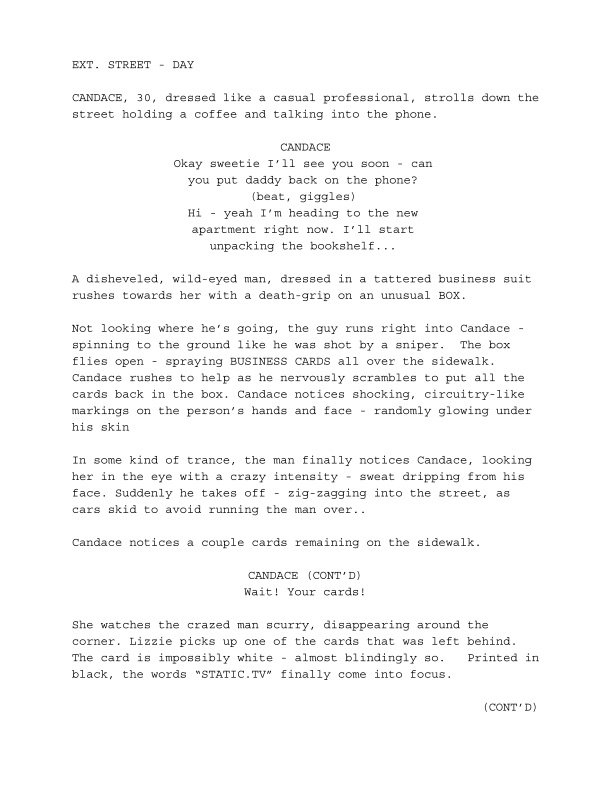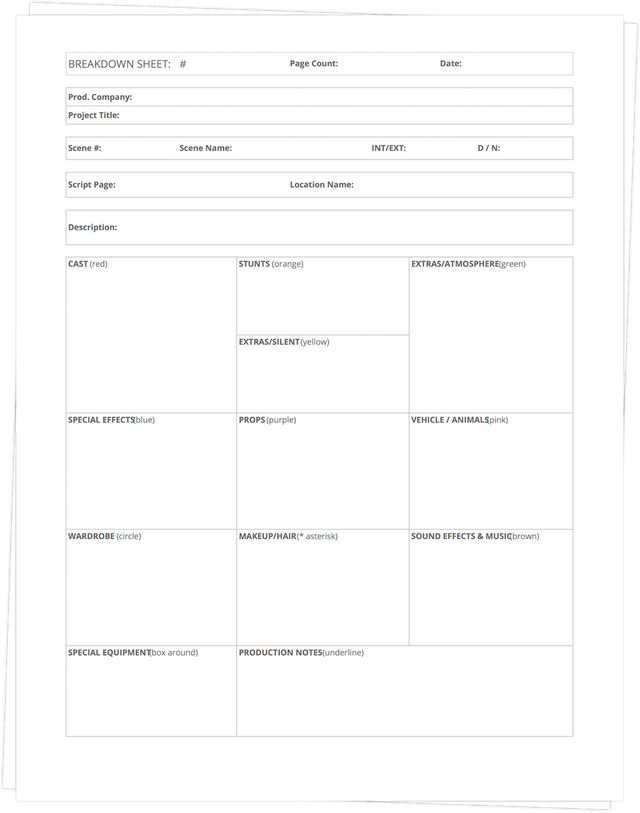Moviemaking Concepts: Pre-Production - Breaking Down the Script
Now that the script is complete, the producer can start to figure out all the details on how to make it - like the budget and the schedule. There's also a little bit of a recap from some of the last vlog's concepts as a refresher.
Video Transcript:
Moviemaking Concepts: Pre-Production - Breaking Down the Script
Hello! I am the artist known as DEROSNEC, and welcome to my bi-weekly vlog where I talk about making music, art, movies, and more.
As I explained last week, the written script is the foundation of a film. But once you’ve got it completed, how do you turn it into it a bunch of moving pictures?
The Producer
Many people look to the Director of a movie as the “leader”, however that’s not entirely accurate. Technically and generally speaking, the director is responsible for leading the creative - as in, the mood, the look, the story, and the performance. The leader of the practical and logistical aspects of making a film is the responsibility of the Producer.
Many directors also produce, and will end up having a heavy hand in these decisions, but they are two very distinct roles which require very different headspaces.
In an ideal filmmaking environment, the director can relinquish control of some or most of the business aspects so that he/she can focus on the creative vision. This means that the producer and his or her production team (which is usually made up of Production Managers and Coordinators) takes over managing the day to day operations like hiring and overseeing vendors and crew, ensuring the project is staying on budget, securing financing, handling the legal stuff, and just generally keeping everything running smoothly.
But before they can do any of that, they have to break down the script to understand what’s actually needed to create it. From there, they can make a budget, get the money, and get the ball rolling.
A Typical Script Breakdown
Breaking down a script is actually quite easy, especially if the script is formatted properly. Let’s look at a script page:

*The first page from my last short film script, STATIC
The scene header tells us the location and the time of day. If you know what types of locations you need, your Location Scout can start to get that information easily and find out the look, cost, and rules for each place needed. Some locations, especially outdoor ones, will need permits, so there’s potentially a lot of extra paperwork and time needed. The time of day will let you know what your lighting needs are - for example, if it’s an outside night shoot in the middle of the forest, then you will likely need a generator or be prepared to spring for a lot of extra batteries!
Within the action text, descriptions of people, places, objects, and FX are called out. This is all important information for the Production Designer, Art Director, as well as the Special Effects, Visual Effects, Stunt, and Prop teams to know. All those objects and descriptions will need to be in the film, especially if they’re important to the story (and chances are, if it’s a good script, those things are only mentioned if they are). You’ll also of course know what types of characters and people will be needed as actors, or if you’ll need a crowd.
Dialogue is usually superseded by a character name, so you know who has actual lines to say. Many times scenes without dialogue or any important synced sound are recorded without sound, which can be a cost saver.
Lists, Schedules, and Budgets
Once the script is broken down into categories, you can figure out the people you need to get everything done. For example, if there are no special effects, then there’s no need to hire a special effects person. The delegating begins!

*A typical script breakdown sheet, via Studiobinder.com
The character list with descriptions is given to a Casting Director, to find actors. The props list is given to the Art and Props Department, to determine what needs to be built and what can be bought. Locations to the Locations team, and so on, until all the needs of the film are met by a specialist in whatever topic needs to be covered.
At this point the producer will work with the Director and the Director of Photography (or DOP) to figure out what kind of camera and formats to shoot with, including light kits and lenses - and at its most basic, the producer finally has enough information to put together a production schedule which lists milestones for all the phases to be completed.
Working together with all the department heads, a budget is assembled which includes all of the costs, including not only all the hard costs like rentals, builds, technology and gear, but also the crew. This is where the schedule comes in handy, because for example you won’t need the entire camera and electrical department to come on until you’re actually shooting, and we still have a lot of prep - or Pre-Production - to do before anyone steps foot on a set.
Flexibility
Just like any kind of project, things change and evolve, and the creative process can make it so that the budget or schedule also need to evolve. This is totally normal and good producers will account for some degree of contingency in their first drafts. But of course, you never want to go too far off course, because usually the investors who are footing the bill for all of this expect things to be run as efficiently as possible. Producing is one of the hardest jobs of a film in that a true balance of creativity, management ability, and business savvy need to be present in the person who’s in that position.
What other types of information do you think is important to know before starting a me what I missed in the comments!
Thanks for watching - hit that thumbs up button below - it helps me more than you know - and join the uncensored by subscribing to my Youtube channel, my newsletter, or by following me on facebook, twitter, and instagram! If you never want to miss a video, be sure to click the little notification bell icon, too.
NOTE: These Thursday Vlog transcripts can also be found published on my website: http://derosnec.com














Nice breakdown of the process.
I wonder if storyboarding comes between the script and breakdown, or after both of them?
I would imagine you'd need a storyboard to have a clearer picture of what is needed for the breakdown sheet.
Great question! There isn't really a set order - in fact it's a great representation of why a lot of this stuff is very fluid and needs to be flexible.
Generally speaking, you have to have a clue as to what the project is going to cost, so that you can get the financing and then actually hire artists - so it behoves the producer to do a first pass breakdown, that's maybe not super crazy detailed, but takes into account a bit of a buffer for the not so obvious.
This will also help to ensure that all the artists and departments actually stay within the budget. Trust me, if you let an artist go nuts, they will, and they'll 9 times out of 10 come up with something that's going to be to expensive to realistically achieve. Unless the director/EP is well established, like a Marvel project, or Spielberg or Tarantino, etc, it's unlikely the project will get a crazy huge do-whatever-you-want budget!
Once financing is secured, more detailed breakdowns can be made, and THOSE will be the ones that are sent over to the departments who need them.
I'm talking about Storyboards next time, so definitely come back to see that as that may answer a few of these questions as well!
Congratulations! This post has been upvoted from the communal account, @minnowsupport, by derosnec from the Minnow Support Project. It's a witness project run by aggroed, ausbitbank, teamsteem, someguy123, neoxian, followbtcnews, and netuoso. The goal is to help Steemit grow by supporting Minnows. Please find us at the Peace, Abundance, and Liberty Network (PALnet) Discord Channel. It's a completely public and open space to all members of the Steemit community who voluntarily choose to be there.
If you would like to delegate to the Minnow Support Project you can do so by clicking on the following links: 50SP, 100SP, 250SP, 500SP, 1000SP, 5000SP.
Be sure to leave at least 50SP undelegated on your account.
Hello @derosnec, thank you for sharing this creative work! We just stopped by to say that you've been upvoted by the @creativecrypto magazine. The Creative Crypto is all about art on the blockchain and learning from creatives like you. Looking forward to crossing paths again soon. Steem on!
Congratulations! This post has been chosen as one of the daily Whistle Stops for The STEEM Engine!
You can see your post's place along the track here: The Daily Whistle Stops, Issue 230 (8/18/18)
The STEEM Engine is an initiative dedicated to promoting meaningful engagement across Steemit. Find out more about us and join us today.
Congratulations @derosnec! You have completed the following achievement on Steemit and have been rewarded with new badge(s) :
Click on the badge to view your Board of Honor.
If you no longer want to receive notifications, reply to this comment with the word
STOPDo not miss the last post from @steemitboard:
SteemitBoard and the Veterans on Steemit - The First Community Badge.